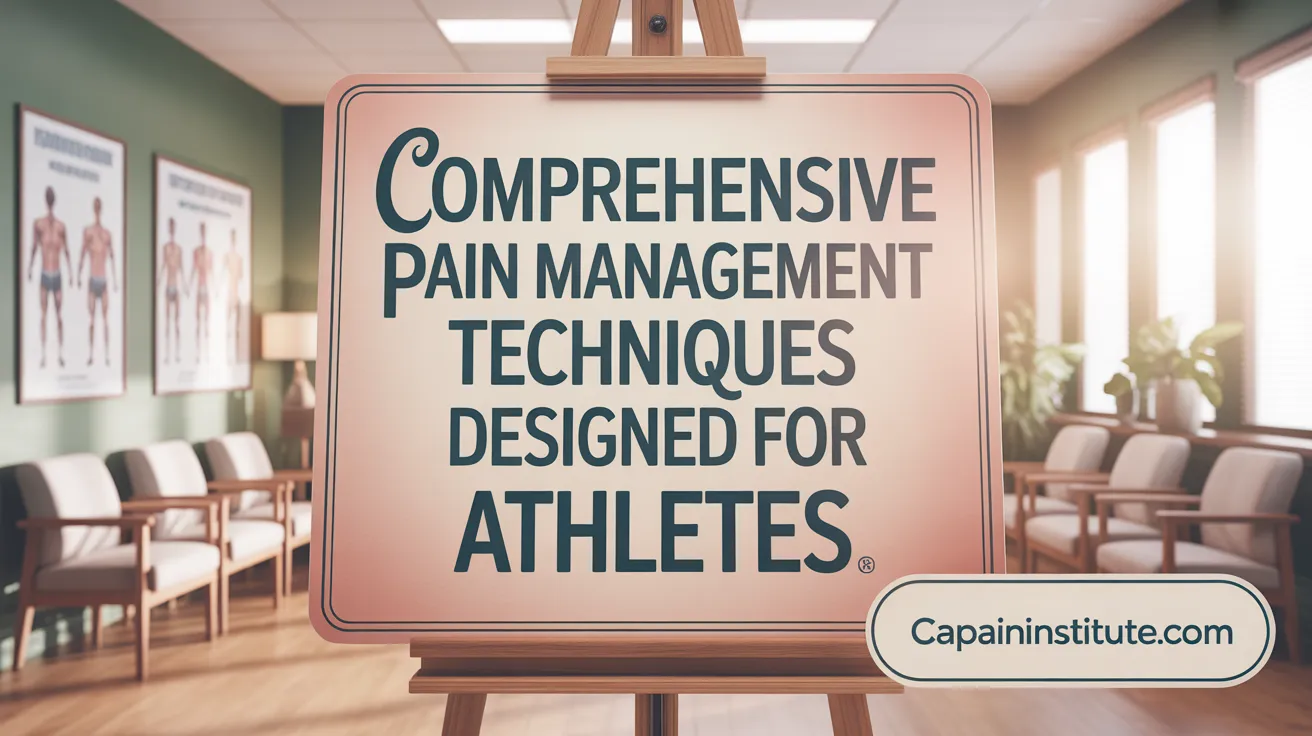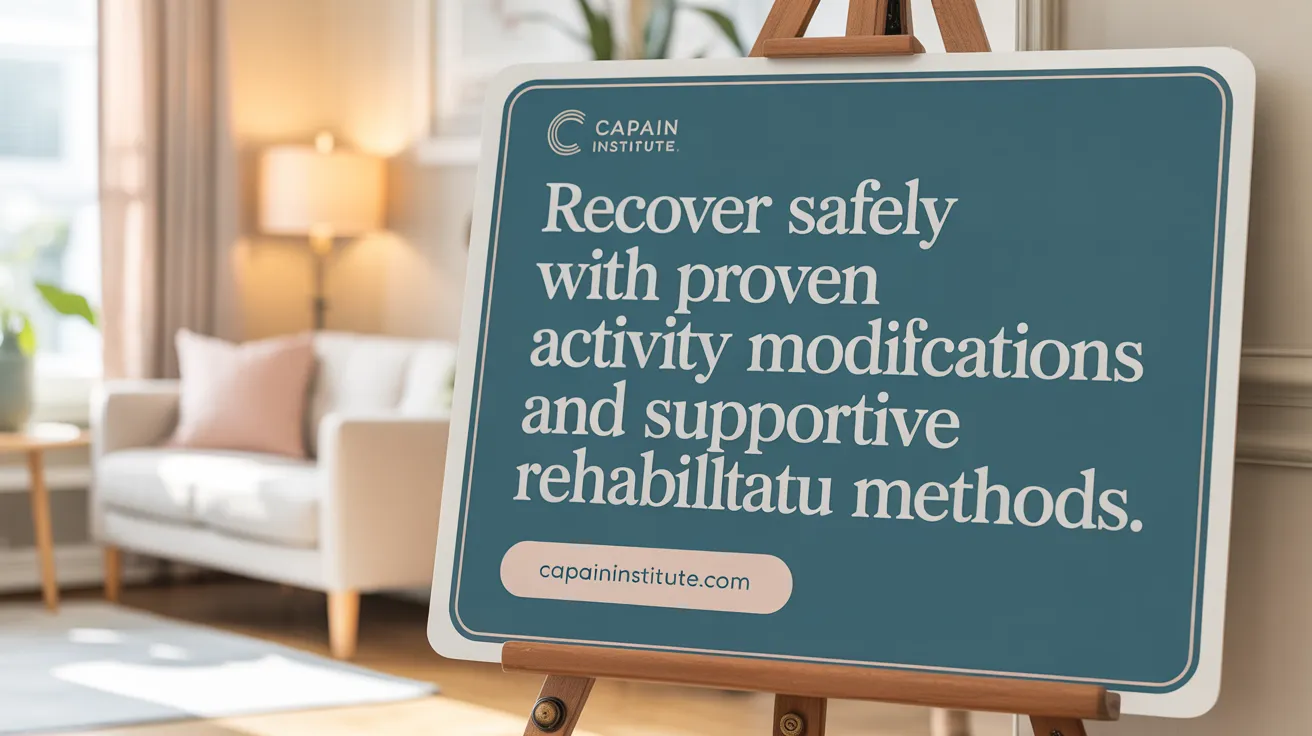Understanding Pain and Injury in Athletics
Athletes and active individuals often face pain and injury related to their physical pursuits. Understanding the distinction between beneficial exercise-related discomfort and harmful pain signaling injury is crucial. Effective pain management encompasses timely diagnosis, appropriate interventions, and tailored rehabilitation to ensure quick recovery and sustained performance. This article explores a spectrum of pain management techniques, injury prevention strategies, and recent advances in sports medicine that support athletes in managing acute and chronic pain while optimizing performance and well-being.
<!-- VIDEO:eyJsaW5rIjoiaHR0cHM6Ly93d3cueW91dHViZS5jb20vd2F0Y2g/dj1mU09MeHd5SjZNYyIsImltYWdlVXJsIjoiZGF0YTppbWFnZS9qcGVnO2Jhc2U2NCwvOWovNEFBUVNrWkpSZ0FCQVFBQUFRQUJBQUQvMndDRUFBa0dCd2dIQmdrSUJ3Z0tDZ2tMRFJZUERRd01EUnNVRlJBV0lCMGlJaUFkSHg4a0tEUXNKQ1l4Sng4ZkxUMHRNVFUzT2pvNkl5cy9SRDg0UXpRNU9qY0JDZ29LRFF3TkdnOFBHamNsSHlVM056YzNOemMzTnpjM056YzNOemMzTnpjM056YzNOemMzTnpjM056YzNOemMzTnpjM056YzNOemMzTnpjM056YzNOLy9BQUJFSUFGTUFsQU1CRVFBQ0VRRURFUUgveEFBYkFBQUJCUUVCQUFBQUFBQUFBQUFBQUFBQUFRSURCQVVHQi8vRUFFWVFBQUVEQWdJRUNBZ0xCd1VBQUFBQUFBRUNBeEVBQkFVaEVoTXhRUVlVRlZGVVlaUGhGaUpUY1lHUmtzRUhNak0xUW1KeWM2SFIwaU1rUTFLaXNmQmpaSUxpOGYvRUFCc0JBUUFEQVFFQkFRQUFBQUFBQUFBQUFBQUJBZ01HQkFVSC84UUFOaEVBQWdFQ0FRa0ZCZ1lEQUFBQUFBQUFBQUVDQXhFaEJBVVNGREZSVXFIUkV4VWlVMkV5UVhHUnNmQXpRbFNCb3NFV2N1SC8yZ0FNQXdFQUFoRURFUUEvQVBGK1RyMGlSWjNIWktvQTVPdnVoM1BaS29BNU92dWgzSFpLb0E1T3Z1aDNQWktvQTVPdnVoM0haS29BNU92dWgzSFpLb0E1T3Z1aDNIWktvQTVPdnVoM0haS29BNU92dWgzSFpLb0E1T3Z1aDNIWktvQTVPdnVoM0haS29BNU92dWgzSFpLb0E1T3Z1aDNIWktvQTVPdnVoM0haS29BNU92dWgzSFpLb0NGNWgxaFFTKzB0dFJFd3RKQm9DT2dDZ0NnUFRXcDFhTm54UlVZbC9CYll6Y3M4TXcyNXQybEt4VkREcW9DMHJBT2lUQTZ0OCtpRFVsQnZFTUtRK3dEaXBkYldxRjZEV2pvalBlZk1CNmFBbFJoZUVPT09KUmpRRW1HcGFJSHh0cFBNQlBOejgwZ1loaWZGbU4wMEFsQUZBRkFGQUZBRkFGQUZBRkFGQWNmd3orY1dmdVIvYzBCejlBRkFGQWVtdGZKSSt5S0ExbU1VWmJZYmFkd3kxZUNBQktzaVluT1Judm9CVGl6UVVyVllaWm9TcENVRkpUcERJa3o1elA0Q2dHWGVJV3o5dXR0dkM3Wmhhb2h4Qk1qUC9CUUdkUUJRQlFCUUVTcmxwSklVc0FqYldUcjAwN05udnA1c3l1cEJUakRCL0FUalRIbEJVYXhUM2wrNk10NE9hRGpUSGxCVFdLZThkMFpid2MwSEcyUEtDbXNVOTQ3b3kzZzVvT05zZVVGTllwN3gzUmx2QnpRY2FZOG9LYXhUM2p1akxlRG1nRjB5VEFXSnByRlBlUTgwNVpGTnVITkhLOE0vbkZuN2tmM05iSHpqbjZBS0FLQTlQdHhwSWJIT2tVQk1scEt2cG4yZStnSmsyZWw5TSt6MzBBOFlmUDhBRlBzZDlBS2NPLzFUN0hmUURGV1VmeEQ3UGZRRUsyQW42Wjludm9DTmFRbUlNZ2lka1VCVHNiWnk4dm5MZGhhRU91TGhLMW1BTnBPZm9yNWNrNVZHa2R4VHF4cFpGVG5OWFNpdG53UmE0U1d6VnU0aExickMxNktkYWhoUktVSzhiWlBPSXlwVmlvc1p1cXlxSnRwMnh0ZmExaC8xR1VscTNMWUtyaFNWNzA2cVl6NTVyTlczbnZjcWw3S09IeEVmYlpRa0ZsOHVFN1FXOUdLaDJKaEtiZmlWdjNJYWcwQ2dITmZLbyswS21PMHlyZmhTK0RPdndQNE83TGhtSHJ1N3hGKzFVd1EwRXRvU29FUk01K2V2c04yWitjSXRZajhDbURXVFdtZUVENE1Fd3RDQk1jMmRWY2lVbTlobDJ2d1NXRDY4OFZ1TkFwQ2txUzJuTUdta0dyTWRjZkJIaHpTd2tZcmRIS2ZrMDFPa1FVclQrRDVrMVlGeTNDU3JRQlNWQVNRRG1CNXFBMHJaaFMxQktVbFNqc0FFbWdMcXJSeG9oTHJha0VpUUZDSm9BTEkzaWdPZVhoK00yUzNTSGhkc29zMVA1cGxUamsvRkFtVTVHY3BHUkZBVzdheHZydTJRNm16ZDBpa2FRU2trQXhtSm9EUGZFRkkrcjd6UUdlcHRnT0xWeGhTRkU1Z0tpdkZPblMwbTNJNlRKOHN6Z3FNWXhvM1NXRHMrbzFUZHV2NDEwdFE2MVRVZG5SNHpaWmJuSmJLQytUNmpkUmErWFByRlIyVkhpTGEvblB5T1Q2aHFMWHk1OVlwMlZIaUd2NXo4amsrb2FpMTh1ZldLZGxSNGhyK2MvSTVQcUdvdGZMbjFpblpVZUlhL25QeU9UNmlvWnRRdEpEMGtISVNLbFVxTi9hS1ZNdXpqb1BTbzRXM1BxZWhmQi9pYlZreGNzckowM0gweEVjMFY2NUhMSkZ6aGZmV2J6N0NuYjF0dExTVkZhUjQ2akJFUUJzMjFoS1YzZ2V1aXRHTHVIQlhFbUwyeGJYYnFVdHRDUzJGbE9qcHdUK2NlaXRJN0RDcGJTd0xkODcrMkgyYWt5UE5MUGF6L0FNYTFKTksyNFBwdjlYZVdyVGh1VzdtU1FmRkpLVWdhUmpJQ0JzOStZbERWM2FXTHBOcmlqSGpJWWZ1Qzh3K3RwVFliQlBpZnpLeTNtSUozMUNkMWNtVWRGMk9qd1RFTVJ4UEEyYjI5V2l5dDNHZEpPcGRKY2Nnd0ZLVWNna3hzRWtnenBWSlVsY1FBTTZBYzgzZE5QYTBNZnNXck54RHVtRHBFNkoyZFFDaG5WWEszdUx4Z243ekN3L0dMVnpHTGUxNElNTzNXdUJSZEc0ZldMWkxtNGc1eWQ1Z2J1c21yRkNEaE1wMWVKQmR3NEhIRk1vSlVCQTlBemdkUko4OUFjOWFCQ3IxYVZ0QjNTY0NkSEtjekdVNVY4dVg0ak80cE5ySTZiVHQ0ZjZKTWFidG1WbE5vbEphQkJTNmtnNndIUzJSNW84NE96WlZhaVNka2E1SE9wS042bTNkdTJEclhpL0ZXa3FRMFZxR1pPcWtiZWRVN3Q5RmEyd21wcDZieGZQb1NnV3lUbTB3UUJHMW5tSDE4OTlXdys3ZFNqMDk3L2wwRVNMY0ZLZFhiK0xrWkxPWTl2YitkTVB1M1VOejIzZVArM1FWemk2czBJWXkyWk1pVEgyNmpEN3QxQzAxNzMvTG9VNzV0cEQ3SmJnRXJJS1JvUUlQMVNlZmYxVkg1a2FKeWRLZDkzcjY3MGRad1lkd2RGcmRERmNPTDdpbkVoRDJnU0VnaUFreDF6WDFKSEJRdGJFMzNjRXdodldQdVdxQTAyZ3JLTnBBL1BJVld5dGRvblRsN0tlQlBnU01LZXNuV3NKYTR2eFpVYXNSc01rRVFUdHpvbW1zQ3NsSlB4R0pqUzd0dThDVVBLQTBQZWFGa2tjclpRVk1TWUhpeWVhdENndDVZOEo3SzRiZHdyRUV0VzF5dFg3d3k1NHFRQ0lFRVNESHYyWmlnT3F3OTlKRGE4U2JhdXJ4REttdU9hb0ljSVVET3pLSk96cXFFa2lYSnZhWFdsTXVXcjFzOGtGdDVPZ3RDaEtGRExJai9BTnFTQ25qRnBjWWxoNjdXeGRhUThwU1lDeVV5QVpnSGRzSFA1cUE1M0M3ZmhPVVBJeHZGcmhxM1dndEtzMjFnbFNZZ3lyZE1ic3p6MEJiQ0diZENHbW13aHBFQUlSNHNEcW9DSEc3bE4zZUlkU3B4UTFLRXk0YzhoRkFZaW1CckZxVGNsQlVjd0RIdnJ4VG93Y205S3gwZVQ1MHJ4b3hncUYwbHR4NkRWVzRXSVhkRWpyTSsrcTloRGpObG5iS0ZzeVo4K2hPMnA1dG9OTjNwUzJOd0FxM1l4NC9vVWVjcTBwYVR5WjMvQUg2QzZ4L0w5K09XeUFLZGxIaitoSGVOWDlNK2ZRQTdjRFpma2VxblpSNC9vTzhhdjZaOCtnRmJ4RUc5a2RZSCtiNmRsSGorZzd4cS9wbno2RlpGbzJsYVRyZ1lPektvVkNDZnRGcW1kOHBjR25RYXc5ZWc5eThGcmU2TGx3RzBGQU9pWE5HVG5CaXZhem1ValVzOGN1TFBEbHJYZUl1M0xwUlpZU3Q4ZUtORWtyTTljQWVlcVBHTEpndkdoNk9HTGVEWWtYVUJLN1M2MFVQTENoTFFCSnlBSm5OUnJPa210cHZsS3hUTjNFNzIwZWZTcEY2d1JvN2RZbm5QWFd0akZiRGxyVExVK1pOWEtHNi9jTU8ybHNMVmVnMjFJVXl0VXFDaVNaNnhuRTBBTXV4UUZ0RDJXMmdMTm5kdE5QcFc3T1dZSTJBOVlvQ2hjdWFLMUFyQ2lOcWdaQjlOQVp6N20yZ0tUNWtwK3o3elFGUERyWnE2eEZ4dDdTMFpKT2dKVVlCTUpHOG1JcjVqaW5VZHp0NDFaMHNpcHVPMnkrSHVXUG9QeHl3WnMwdEZ0T2hyTXduU25MUE9ZR1I2d0NJSXF0U0dpYTVGbEVxMTAvZDk4dlRBU3p0R25iWnRTN2NxVVFRU0czVE9aNXNxaEpXTDFhczR6YVQ1cit5UlZveGxGdHRCRWh0NzExT2l0eFJWcDhYT0pHNXlhbFFsdHFRWVVnYTBkVy8xK2lvOEpkYXcvZStRaVJoaGo1SWJwSmRwNFE5WTllUlNjVzJ1N1NXbWt0SjBoNHFTU052WFVMMmthelVsUmtwTytEK2hoOE12bkJuN2tmM05mWFB6dEhQMEFVQVVCNmN3ZEZEWjVraWdKa3VoT3hOUmNtekpVM2hUOUVVdUxNZU1RVVBvRDhhWEZtSEtLdjVVL2pRV1l4VjhwVzFBb05Ga1p1QXJhbWx4b3NqVXNLSTNRSXFialJaVTFDMHVxVzI2RWxSbk5FMTQ1Wk0zSnU1ME5IUE1JVVkwNVU3MlZ0b1BzdlBxS25ud3RSektpak0rYzc2alZXL3pHc00rVW9ZUnBjeGd0SEFJRDVBNnBxTlZlOGw1K3B2YlM1b1hpams1dnEvR3AxVjhRNytwK1Z6WFFZYkFreVhmNmFqVkh2Si95Q1BsdjVvT1R6NVQrbW1xUGVUL0FKREh5MzgwS2l3SVVGYXdaR2RsU3NsYWUwcFV6L0dVSEhzOXZxYzd3eitjV2Z1dmVhOXB6Qno5QUZBRkFkT25oYVVvQ2VKQXdBUGxlNmdGOExqMEVkcjNVQWVGeDZDTzE3cUFQQzQ5QkhhOTFBU044TlhXaENMU0JNeHJmK3RBTDRidlFCeFFRUHJqOU5BTDRjUHlEeFFTQkh4eCttZ0R3NWZpT0tpUHZCK21nRUhEZDRDQmFEdEIrbWdGOE9IdExTNG9KbWZsQnRpUDVhQVh3NWZtZUtKOXNmcG9DRHd1L3dCaU8xN3FBUEM0OUJIYTkxQUhoY2VnanRlNmdEd3VQUVIydmRRR1BqT0pjcDNDSHRWcTlGR2pHbE8velVCbjBBVUFVQVVBVUFVQVVBVUFVQVVBVUFVQVVBVUFVQVVBVUFVQVVBVUFVQVVCLzlrPSIsInRpdGxlIjoiRXhlcmNpc2UgaXMgTWVkaWNpbmU6IExpZnRpbmcgQXdheSBZb3VyIFBhaW4gfCBPaGlvIFN0YXRlIC4uLiIsInNuaXBwZXQiOiJTdHJlbmd0aCB0cmFpbmluZyBpc24ndCBqdXN0IGZvciBhdGhsZXRlcyBhbmQgYm9keSBidWlsZGVycyAuLi4gRXhlcmNpc2UgaXMgTWVkaWNpbmU6IExpZnRpbmcgQXdheSBZb3VyIFBhaW4gfCBPaGlvIFN0YXRlIE1lZGljYWwgQ2VudGVyLiJ9 -->Techniques and Treatments for Managing Pain in Athletes

What are the pain management options and techniques for athletes and active individuals?
Athletes and active individuals have access to a broad spectrum of pain management options designed to facilitate recovery while minimizing downtime. The initial approach often involves the RICE method—Rest, Ice, Compression, and Elevation—which helps control acute inflammation and swelling immediately after injury.
Over-the-counter medications also play a vital role in managing pain. Non-steroidal anti-inflammatory drugs (NSAIDs) such as ibuprofen and naproxen are commonly used to reduce pain and inflammation. Acetaminophen provides an alternative for pain relief without anti-inflammatory effects.
For more targeted intervention, injections are frequently utilized. Corticosteroid injections can swiftly reduce inflammation in tendons or joints, easing pain and allowing continued activity. Platelet-Rich Plasma (PRP) therapy, which uses the patient's own platelets to accelerate tissue healing, and stem cell therapies aim to repair damaged tissues at a cellular level.
Physical therapy remains a cornerstone of pain control, involving tailored exercises that strengthen muscles, improve flexibility, and restore function. Techniques such as manual therapy, massage, and electrical stimulation—commonly through Transcutaneous Electrical Nerve Stimulation (TENS)—aid in alleviating discomfort and promoting recovery.
Complementary approaches like acupuncture, biofeedback, meditation, and psychotherapy can support pain management, especially for chronic conditions or pain related to psychological factors.
Overall, effective pain management hinges on a comprehensive, individualized plan carefully coordinated by sports medicine specialists. These healthcare providers assess the injury, recommend appropriate interventions, and monitor progress to ensure safe and efficient recovery.
Strategies for Managing Acute and Chronic Sports-Related Pain
 Managing sports-related pain effectively requires a comprehensive approach that addresses both immediate injuries and long-term issues.
Managing sports-related pain effectively requires a comprehensive approach that addresses both immediate injuries and long-term issues.
How to handle acute sports injuries involves quick, targeted actions. The RICE method—Rest, Ice, Compression, and Elevation—is a common first step to reduce swelling and pain. Applying ice packs for about 20 minutes as soon as possible after injury helps limit inflammation. Pain relief medications such as NSAIDs (like ibuprofen) are often used to alleviate discomfort and diminish inflammation. Immobilization with slings, braces, or casts may be necessary depending on the injury severity.
What causes chronic pain and how to treat it when injuries do not heal as expected? Chronic pain can stem from ongoing inflammation, tissue degeneration, or inadequate initial treatment. Conditions such as tendinitis, osteoarthritis, or persistent ligament damage fall into this category. Treatments include corticosteroid injections to reduce inflammation, shockwave therapy to promote healing, and advanced regenerative methods like PRP (Platelet-Rich Plasma) or stem cell injections that help repair damaged tissues.
Physical therapy’s crucial role in recovery cannot be overstated. Customized exercise programs strengthen muscles, restore flexibility, and help prevent future injuries. Therapists might use ultrasound therapy, electrical stimulation like TENS, or manual massage to enhance recovery and manage pain.
Medications and injections are tailored to control pain and inflammation. Besides NSAIDs, doctors may recommend muscle relaxants, corticosteroid injections, or viscosupplementation for joint conditions. These treatments aim to reduce discomfort, improve joint function, and facilitate recovery.
Preventative strategies are vital to avoid recurring injuries. Proper warm-up routines, wearing suitable protective gear, gradual progression of training intensity, and listening to warning signs from the body contribute to injury prevention. Maintaining a healthy weight, good nutrition, and a balanced training program further decrease injury risk.
Summary Table of Injury Management Steps:
| Approach | Techniques & Tools | Goals |
|---|---|---|
| Immediate Injury Response | RICE, immobilization, NSAIDs | Reduce swelling, alleviate pain |
| In-Clinic Treatments | Injections, shockwave, PRP, stem cells | Accelerate healing, reduce inflammation |
| Rehabilitation & Physical Therapy | Exercises, ultrasound, electrical stimulation | Strengthen muscles, restore mobility |
| Preventative Measures | Proper training, gear, warm-up routines | Minimize future injuries |
By combining these strategies, athletes can manage their pain effectively, recover faster from injuries, and reduce the risk of long-term problems. Whether dealing with a sudden injury or managing ongoing discomfort, a multidisciplinary approach ensures optimal care and safer return to activity.
The Integral Role of Sports Medicine in Injury Prevention and Recovery

What role does sports medicine play in injury prevention, treatment, and recovery?
Sports medicine is a specialized field dedicated to helping athletes and active individuals avoid injuries, recover efficiently, and return to optimal performance. It begins with injury prevention, where professionals conduct thorough physical evaluations and provide personalized recommendations. These include proper training techniques, effective warm-up and cool-down routines, strength training, and the use of appropriate sports equipment to lower the risk of injury.
When injuries occur, sports medicine practitioners are equipped to diagnose and treat a wide range of sports-related conditions. They utilize medical assessments, imaging technology, and personalized rehabilitation plans. Treatments may involve physical therapy, medications, injections such as corticosteroids or platelet-rich plasma (PRP), and surgical procedures if necessary.
A key aspect of sports medicine is developing tailored recovery programs. These programs include staged rehabilitation, functional testing, and gradual reintroduction of activity to ensure athletes recover fully and safely. This approach helps prevent reinjury and promotes long-term health.
Preventive strategies like load monitoring, biomechanics analysis, and injury screening are also vital. They help identify risk factors early, enabling targeted interventions that enhance performance and minimize long-term damage.
Overall, sports medicine integrates prevention, precise diagnosis, effective treatment, and personalized rehabilitation to assist athletes in maintaining their health, maximizing performance, and safely resuming sport activities. Its comprehensive approach ensures that athletes not only recover from injuries but do so in a way that promotes their ongoing physical well-being.
| Aspect | Approach | Additional Details |
|---|---|---|
| Injury prevention | Evaluation, education, proper techniques | Warm-up routines, equipment use, strength training |
| Diagnosis and treatment | Medical assessment, imaging, therapy | Medications, injections, surgical options |
| Rehabilitation | Physical therapy, staged recovery | Functional testing, activity modification |
| Long-term health focus | Load monitoring, biomechanics analysis | Injury screening, performance optimization |
This integrated approach by sports medicine specialists plays a vital role in safeguarding athletes' health while optimizing their performance and ensuring a safe, sustained return to their sport or active lifestyle.
Safe Activity and Rehabilitation Techniques During Injury Recovery

What are effective techniques for safe activity and recovery during injury rehabilitation?
Recovery from sports injuries involves a careful and systematic approach designed to restore function, reduce pain, and prevent future injuries. One fundamental method is implementing a structured, phased rehabilitation program. This program guides athletes through stages of healing by gradually increasing activity intensity, always guided by healthcare professionals such as physical therapists.
Manual therapy and tailored exercise regimens form the core of effective rehabilitation. Techniques like joint mobilizations and soft tissue massage help regain mobility and reduce stiffness. As healing progresses, resistance exercises and mobility drills are introduced to rebuild strength and flexibility without overloading tissues.
Supporting these physical interventions are essential measures such as proper nutrition and hydration, which promote tissue repair. Adjunct therapies like cryotherapy (cold therapy) can help decrease inflammation early in recovery, while photobiomodulation may accelerate healing.
To minimize the risk of re-injury, it's important to incorporate low-impact activities like swimming, cycling, or yoga. These activities maintain cardiovascular fitness and muscle conditioning while sparing injured areas from excessive stress. Using supportive devices such as braces or slings can provide additional stability during early recovery phases.
Monitoring pain and functional progress is vital for safe progression. Athletes should avoid overexertion by listening to their bodies, and recovery plans should be flexible enough to adapt if pain worsens.
Furthermore, mental health support plays a significant role. Staying positive and focused during recovery helps maintain motivation and adherence to rehabilitation protocols.
In summary, combining a phased, guided approach with manual therapy, functional exercises, proper nutrition, and supportive activities ensures a safe and effective return to sport, reducing the likelihood of setbacks or future injuries.
Advances, Modalities, and Benefits of Tailored Pain Management in Sports Medicine

What recent advances and developments in sports medicine are relevant to pain management?
Recent innovations in sports medicine have shifted towards comprehensive, personalized approaches to pain management. Modern protocols emphasize multimodal treatments that combine biological, psychological, and technological interventions tailored to each athlete's specific needs. There is a growing trend to utilize minimally invasive procedures, such as injections and regenerative therapies like Platelet-Rich Plasma (PRP) and stem cell treatments, which directly target the source of pain and promote rapid healing.
New guidelines discourage overreliance on opioids, promoting nonpharmacologic strategies like physical therapy, acupuncture, biofeedback, and mental health support. Technological advances, including wearable devices and artificial intelligence, help in precise injury diagnosis, injury monitoring, and performance optimization. These evolving treatments aim to improve recovery times, reduce re-injury risks, and enhance athletic performance through integrated, multidisciplinary methodologies.
What are the common treatment modalities used in sports medicine including therapies, interventions, and preventive care?
Sports medicine employs a wide array of treatments to manage pain and prevent injuries. Pharmacological options include NSAIDs, corticosteroid injections, and muscle relaxants to control mild to moderate pain. Physical modalities such as stretching, strengthening exercises, manual therapy, and ultrasound promote tissue repair and improve flexibility.
Supportive therapies like cold packs, ice therapy, whirlpool treatments, and laser therapy help reduce swelling, numb pain, and accelerate healing. Alternative therapies include massage, acupuncture, paraffin baths, and low-level laser therapy, which aid in circulation, muscle relaxation, and tissue regeneration.
Preventive strategies focus on proper warm-up routines, biomechanical assessments, correct training techniques, and nutritional guidance to minimize injury risk. During rehabilitation, athletes undergo staged recovery involving pain management, mobility exercises, and sport-specific training, ensuring a safe return to activity.
How does tailored pain management and injury treatment benefit athletic performance?
Customized approaches to pain and injury care significantly elevate athletic outcomes. Targeted treatments like PRP, nerve blocks, and radiofrequency ablation allow precise alleviation of pain at its source, minimizing downtime and enabling athletes to recover faster.
Effective pain control restores normal function, allowing athletes to train more intensely and compete at higher levels. Moreover, reducing discomfort improves mental concentration and confidence, essential components of peak performance. By preventing re-injury through personalized rehabilitation plans, athletes sustain their performance longevity.
In essence, tailored pain management not only accelerates physical recovery but also enhances psychological well-being, leading to improved focus, resilience, and overall athletic achievement.
Optimizing Athletic Health Through Informed Pain Management
Pain management and injury care are foundational to the longevity and success of athletes and active individuals. Combining proven acute care methods, advanced regenerative therapies, and comprehensive rehabilitation protocols under the guidance of sports medicine experts allows for tailored approaches that promote faster healing and minimize the risk of reinjury. Incorporating preventive strategies and mental health support further enhances recovery experiences and performance outcomes. By staying informed about evolving treatments and maintaining an interdisciplinary approach, athletes can safely push their limits while preserving their physical health and overall well-being.
References
- 9 Best Options in Pain Management for Athletes
- How to Manage Chronic Pain from Sports Injuries
- The Power of Interventional Pain Management for Athletes - AOSMI
- University of Miami Sports Medicine Institute
- Unlock Sports Medicine Benefits for Peak Performance
- Effective Sports Medicine Treatments for Managing Athletic Pain
- How Sports Medicine Is Used in Pain Management
- Staying Active While Recovering From A Sports Injury
- Sports Medicine to Treat Pain and Injuries | Temple Health
